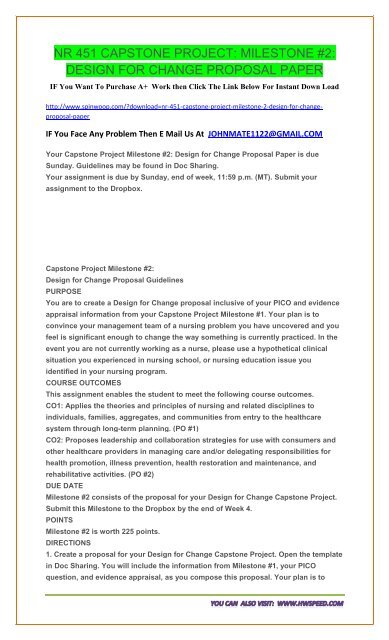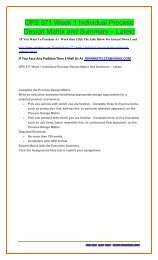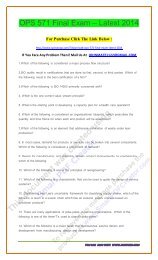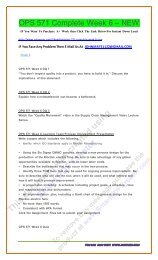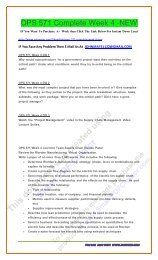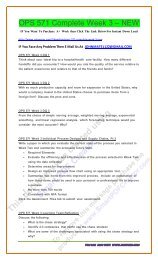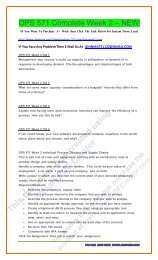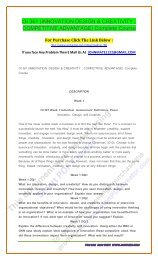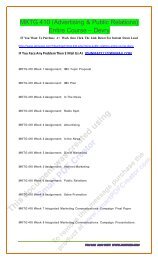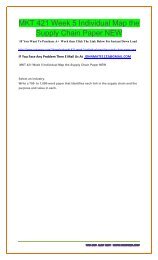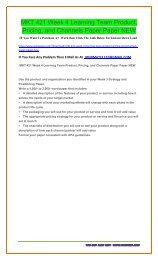NR 451 CAPSTONE PROJECT
You also want an ePaper? Increase the reach of your titles
YUMPU automatically turns print PDFs into web optimized ePapers that Google loves.
<strong>NR</strong> <strong>451</strong> <strong>CAPSTONE</strong> <strong>PROJECT</strong>: MILESTONE #2:<br />
DESIGN FOR CHANGE PROPOSAL PAPER<br />
IF You Want To Purchase A+ Work then Click The Link Below For Instant Down Load<br />
http://www.spinwoop.com/?download=nr-<strong>451</strong>-capstone-project-milestone-2-design-for-changeproposal-paper<br />
IF You Face Any Problem Then E Mail Us At JOHNMATE1122@GMAIL.COM<br />
Your Capstone Project Milestone #2: Design for Change Proposal Paper is due<br />
Sunday. Guidelines may be found in Doc Sharing.<br />
Your assignment is due by Sunday, end of week, 11:59 p.m. (MT). Submit your<br />
assignment to the Dropbox.<br />
Capstone Project Milestone #2:<br />
Design for Change Proposal Guidelines<br />
PURPOSE<br />
You are to create a Design for Change proposal inclusive of your PICO and evidence<br />
appraisal information from your Capstone Project Milestone #1. Your plan is to<br />
convince your management team of a nursing problem you have uncovered and you<br />
feel is significant enough to change the way something is currently practiced. In the<br />
event you are not currently working as a nurse, please use a hypothetical clinical<br />
situation you experienced in nursing school, or nursing education issue you<br />
identified in your nursing program.<br />
COURSE OUTCOMES<br />
This assignment enables the student to meet the following course outcomes.<br />
CO1: Applies the theories and principles of nursing and related disciplines to<br />
individuals, families, aggregates, and communities from entry to the healthcare<br />
system through long-term planning. (PO #1)<br />
CO2: Proposes leadership and collaboration strategies for use with consumers and<br />
other healthcare providers in managing care and/or delegating responsibilities for<br />
health promotion, illness prevention, health restoration and maintenance, and<br />
rehabilitative activities. (PO #2)<br />
DUE DATE<br />
Milestone #2 consists of the proposal for your Design for Change Capstone Project.<br />
Submit this Milestone to the Dropbox by the end of Week 4.<br />
POINTS<br />
Milestone #2 is worth 225 points.<br />
DIRECTIONS<br />
1. Create a proposal for your Design for Change Capstone Project. Open the template<br />
in Doc Sharing. You will include the information from Milestone #1, your PICO<br />
question, and evidence appraisal, as you compose this proposal. Your plan is to
convince your management team of a nursing problem you have uncovered and you<br />
feel is significant enough to change the way something is currently practiced.<br />
2. The format for this proposal will be a paper following the Publication manual of<br />
APA 6th edition.<br />
3. The paper is to be four- to six-pages excluding the Title page and Reference page.<br />
4. As you organize your information and evidence, include the following topics.<br />
a. Introduction: Write an introduction but do not use “Introduction” as a heading in<br />
accordance with the rules put forth in the Publication manual of the American<br />
Psychological Association (2010, p. 63). Introduce the reader to the plan with<br />
evidence-based problem identification and solution.<br />
b. Change Plan: Write an overview using the John Hopkins Nursing EBP Model and<br />
Guidelines (2012)<br />
i. Practice Question<br />
ii. Evidence<br />
iii. Translation<br />
c. Summary<br />
5. Citations and References must be included to support the information within each<br />
topic area. Refer to the APA manual, Chapter 7, for examples of proper reference<br />
format. In-text citations are to be noted for all information contained in your paper<br />
that is not your original idea or thought. Ask yourself, “How do I know this?” and<br />
then cite the source. Scholarly sources are expected, which means using peerreviewed<br />
journals and credible websites.<br />
6. Tables and Figures may be added as appropriate to the project. They should be<br />
embedded within the body of the paper (see your APA manual for how to format and<br />
cite). Creating tables and figures offers visual aids to the reader and enhances<br />
understanding of your literature review and design for change.<br />
GRADING CRITERIA: DESIGN FOR CHANGE <strong>CAPSTONE</strong> <strong>PROJECT</strong><br />
Category Points % Description<br />
Introduction 25 11% Introduction to the plan is nursing focused, with evidence-based<br />
problem identification and potential solutions clearly identified.<br />
Change Plan; Practice Question (Steps 1–5) 50 22% Activities to achieve the first<br />
steps of change are fully described in detail and are based on the first five steps of<br />
the John Hopkins EBP Process; Practice Question.<br />
Change Plan; Evidence (Steps 6–10) 50 22% Activities to achieve steps six through<br />
ten of the John Hopkins EBP Process are fully described in detail; Evidence.<br />
Change Plan; Translation<br />
(Steps 11–18) 50 22% Activities to achieve the final steps of change are fully<br />
described in detail and are based on steps 11 through 18 of the John Hopkins EBP<br />
Process; Practice Question.<br />
Summary 25 11% Clear, solid summary summarizing the key points and steps of the<br />
change plan is included; ways to maintain the change plan are described.<br />
APA Format 25 11% Minimal errors.<br />
Total 225 points 100%<br />
GRADING RUBRIC: <strong>CAPSTONE</strong> <strong>PROJECT</strong> MILESTONE #2<br />
Assignment Criteria Outstanding or Highest Level of Performance
A (92–100%) Very Good or High Level of Performance<br />
B (84–91%) Competent or Satisfactory Level of Performance<br />
C (76–83%) Poor, Failing or Unsatisfactory Level of Performance<br />
F (0–75%) Total<br />
Introduction<br />
25 points Introduction to the plan is nursing focused, with evidence-based problem<br />
identification and potential solutions clearly identified.<br />
23–25 points Introduction to the plan is nursing focused, with evidence to support<br />
the problem and potential solution identified but convincing areas are missing.<br />
21–22 points Introduction to the plan is provided; however, evidence to support the<br />
problem and potential solution is not convincing.<br />
19–20 points Introduction lacks evidence to support need for change and/or potential<br />
solution is not realistic.<br />
0–18 points /25<br />
Change Plan Practice Question<br />
(Steps 1–5)<br />
50 points Activities to achieve the first five steps of change are fully described in<br />
detail and are based on the first section of the John Hopkins EBP Process:<br />
*Practice question is identified.<br />
*Scope of the problem discussed (including supportive statistics).<br />
*Stakeholders identified.<br />
*Team is identified.<br />
46–50 points Activities to achieve the first five steps of change are fully described,<br />
not in detail but are based on the first section of the John Hopkins EBP Process:<br />
*Practice question is identified.<br />
*Scope of the problem discussed (including supportive statistics).<br />
*Stakeholders identified.<br />
*Team is identified.<br />
42–45 points Activities to achieve the first five steps of change are vague. The first<br />
section of the John Hopkins EBP Process is not clearly identified.<br />
*Practice question is identified.<br />
*Scope of the problem does not contain statistics to support the problem.<br />
*Stakeholders are identified but not appropriate or missing key members.<br />
*Team members are identified but not appropriate or missing key members.<br />
38–41 points Activities to address and support change are not specifically<br />
addressed. Portions of the first five steps are missing or absent.<br />
0–37 points /50<br />
Change Plan Evidence<br />
(Steps 6–10)<br />
50 points Activities to achieve steps six through ten of change are fully described in<br />
detail and are based on the first section of the John Hopkins EBP Process: Evidence<br />
is identified.<br />
*At least four reliable sources are used, three of which are peer-reviewed.<br />
*Summary of evidence is thorough and detailed.<br />
*Strength of evidence is discussed.<br />
*Recommendation for change is based on evidence and is thorough.
46–50 points Activities to achieve steps six through ten of change are vague and are<br />
based on the first section of the John Hopkins EBP Process: Evidence is identified.<br />
*At least four reliable sources are used, three of which are peer-reviewed.<br />
*Summary of evidence is vague.<br />
*Strength of evidence is discussed.<br />
*Recommendation for change is based on evidence but connection is vague.<br />
42–45 points Activities to achieve steps six through ten of change are vague and are<br />
based on the first section of the John Hopkins EBP Process: Evidence is identified.<br />
*At least four reliable sources are used but less than three are peer-reviewed.<br />
*Summary of evidence is vague.<br />
*Strength of evidence is not discussed.<br />
*Recommendation for change is present but not weak connection to the evidence.<br />
38–41 points Activities to achieve steps six through ten of change may be missing or<br />
absent.<br />
*Less than four reliable sources are used.<br />
*Summary of evidence is not present or missing important elements.<br />
*Strength of evidence is missing.<br />
*Recommendation for change lacks support from evidence.<br />
0–37 points /50<br />
Change Plan Translation<br />
(Steps 11–18)<br />
50 points Activities to achieve the last steps of change are fully described in detail<br />
and are based on the last steps of the John Hopkins EBP Process:<br />
Translation. *Action plan is well-developed with specific timeline in place to include<br />
all elements of the plan.<br />
*Measurable outcomes and way to report results are discussed in detail.<br />
*Plan for implementation is thoroughly discussed.<br />
*Ways to communicate findings (internally and externally) are discussed.<br />
46–50 points Activities to achieve the last steps of change are described and are<br />
based on the last steps of the John Hopkins EBP Process:<br />
Translation.<br />
*Action plan is developed with specific timeline in but some elements of the timeline<br />
are missing.<br />
*Outcomes are present but not measurable. Ways to report results are discussed in<br />
detail.<br />
*Plan for implementation is discussed.<br />
*Communication of findings is present but does not address both internal and<br />
external ways.<br />
42–45 points Activities to achieve the last steps of change are vague.<br />
*Action plan is developed but timeline is missing.<br />
*Outcomes are vague and not measurable. Ways to report results are discussed but<br />
not in detail.<br />
*Plan for implementation is vague.<br />
*Communication of findings is missing.<br />
38–41 points Activities to achieve the last steps of change are vague or missing.<br />
*Action plan is not well-developed or missing.
*Outcomes are vague or not present. Ways to report results are discussed but not in<br />
detail.<br />
*Plan for implementation is not present.<br />
*Communication of findings is missing.<br />
0–37 points /50<br />
Summary<br />
25 points Clear, solid summary of the key points and the change plan are included;<br />
ways to maintain the change plan are described.<br />
23–25 points A clear summary of the key points and part of the change plan are<br />
provided; ways to maintain the change plan are mentioned, but not in detail.<br />
21–22 points A summary is present but is vague; parts of the change plan are<br />
highlighted; ways to maintain the change plan are not clear.<br />
19–20 points A summary is difficult to determine or absent. Key points of the change<br />
plan are not recapped or are absent.<br />
0–18 points /25<br />
APA formatting, scholarly writing<br />
25 points APA format sixth edition: third person, grammar, sentence structure,<br />
punctuation, and spelling; sources correctly cited and referenced; title page,<br />
headers, and page numbers. No errors to one error.<br />
23–25 points Two to three errors.<br />
21–22 points Four to five errors.<br />
19–20 points Multiple errors<br />
0–18 points /25<br />
Total Points /225<br />
Reference:<br />
Dearholt, S. L., & Dang, D. (2012).Johns Hopkins Nursing Evidence Based Practice:<br />
Model and Guidelines (2nd ed.). Indianapolis, IN: Sigma Theta Tau International.<br />
Title<br />
Your Name<br />
Chamberlain College of Nursing<br />
<strong>NR</strong><strong>451</strong> RN Capstone Course<br />
Term and Year<br />
Your title here
This paragraph(s) is to introduce the paper. State the problem and potential solutions<br />
backed by evidence. Briefly, introduce the nursing focused plan. Remember this is a<br />
scholarly APA assignment so you cannot use first person.<br />
Change Model Overview<br />
In this first paragraph, provide an overview of the John Hopkins Nursing Evidence-<br />
Based Practice Process. Feel free to state why nurses should use this model as a<br />
guide to facilitate change. Under each of the second level headers listed below, you<br />
now link y<br />
.our identified topic to the John Hopkins EBP Process.<br />
Practice Question<br />
Step 1: Recruit Interprofessional Team<br />
You will be the leader of the team since this is your project. Who will you also include<br />
in your team? Make sure you choose relevant stakeholders. You should have no<br />
more than eight members. Do not list your team members by name but instead by<br />
position (pharmacists, charge nurse etc)<br />
Step 2: Develop and Refine the EBP Question<br />
Restate your question. Include the PICO elements but make sure you write them in<br />
paragraph form and not in list format.<br />
Step 3: Define the Scope of the EBP<br />
Why is this a problem? Give statistics and information to back the scope of the<br />
problem. How does this problem impact healthcare on a broader scale?<br />
Steps 4 and 5: Determine Responsibility of Team Members<br />
Why are the members chosen important to your project? What are their roles?<br />
Evidence<br />
Steps 6 and 7: Conduct Internal/ External Search for Evidence and Appraisal of<br />
Evidence<br />
What type of evidence did you find? EBP guidelines? Quality improvement data?<br />
Position statements? Qualitative research? Quantitative research? Briefly discuss<br />
the strength of this research. This is not where you describe the results of your<br />
studies. This is done in the following steps.<br />
Steps 8 and 9: Summarize the Evidence<br />
Synthesize the information that you obtained from your sources. You will need at<br />
least four sources. Of these four sources, three must be from peer-reviewed articles.<br />
The other source can be from a reputable source. See page 44 of your text for<br />
examples of sources you can use.<br />
In this section, you need to synthesize the information from the articles. Feel free to<br />
cite multiple articles within one sentence. You should avoid one paragraph for each<br />
of the sources.<br />
Step 10: Develop Recommendations for Change Based on Evidence<br />
What is your recommendation based on the research? Ideally, you will have found<br />
enough support in your evidence to proceed with implementing your pilot program.<br />
Translation<br />
Steps 11, 12, and 13, 14: Action Plan<br />
You have not implemented your project yet, therefore, this section will be<br />
hypothetical. Develop your plan for implementation. What are the specific steps you<br />
will take to implement your pilot study? What is the timeline for your plan? Make sure<br />
you include a plan for evaluation of outcomes and method to report the results.
Steps 16 and 16: Evaluating Outcomes and Reporting Outcomes<br />
What are the desired outcomes? How will they be measured? How will you report the<br />
results to the key stakeholders?<br />
Steps 17: Identify Next Steps<br />
How will you implement the plan on a larger scale? Will this be applicable to other<br />
units or the facility as a whole? What will you do to ensure that the implementation<br />
becomes permanent?<br />
Step 18: Disseminate Findings<br />
How will you communicate your findings internally (within your organization) and<br />
externally (to others outside of your organization)?<br />
Conclusion<br />
Provide a clear and concise summary. Review the key aspects of the problem as well<br />
as the change model. Be sure to include important aspects of the three levels of<br />
change for the John Hopkins EBP process.<br />
References


